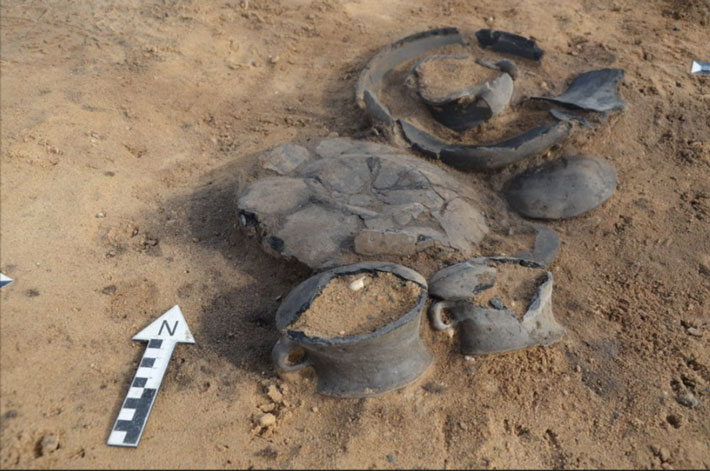 HALLE, GERMANY—According to a statement released by the State Office for Heritage Management and Archaeology (LDA) Saxony-Anhalt, a new study has identified specific functions for several types of pottery vessels unearthed in central Germany. Residues from more than 100 pottery vessels of different sizes, shapes, and contexts were analyzed by researchers from the LDA and the Autonomous University of Barcelona. The scientists found that the increase of consumption of dairy products during the fourth millennium B.C. by the Baalberge Culture was linked to the development of small handled cups. The researchers think these cups may have been used to scoop milk products from larger vessels. Carinated beakers, which feature a rounded base and inward sloping sides, are thought to have been used by Bell Beaker populations of the third millennium B.C. to serve dairy products as well. Beakers recovered from Corded Ware Culture graves dated to the third millennium B.C., however, were found to contain a variety of plant and animal fats. The analysis of the animal fats indicates that pigs were widely consumed. It had been previously suggested that these Corded Ware Culture funerary containers held beer. In contrast, the highly standardized pottery of the Bronze Age Únĕtice Culture (2200–1550 B.C.) was found to contain a greater variety of animal and plant residues, indicating that the pottery was multifunctional in design. Read the original scholarly article about this research in PLOS ONE. To read about early evidence of cheese making recovered from pottery found on Croatia's Dalmatian Coast, go to "When Things Got Cheesy."
HALLE, GERMANY—According to a statement released by the State Office for Heritage Management and Archaeology (LDA) Saxony-Anhalt, a new study has identified specific functions for several types of pottery vessels unearthed in central Germany. Residues from more than 100 pottery vessels of different sizes, shapes, and contexts were analyzed by researchers from the LDA and the Autonomous University of Barcelona. The scientists found that the increase of consumption of dairy products during the fourth millennium B.C. by the Baalberge Culture was linked to the development of small handled cups. The researchers think these cups may have been used to scoop milk products from larger vessels. Carinated beakers, which feature a rounded base and inward sloping sides, are thought to have been used by Bell Beaker populations of the third millennium B.C. to serve dairy products as well. Beakers recovered from Corded Ware Culture graves dated to the third millennium B.C., however, were found to contain a variety of plant and animal fats. The analysis of the animal fats indicates that pigs were widely consumed. It had been previously suggested that these Corded Ware Culture funerary containers held beer. In contrast, the highly standardized pottery of the Bronze Age Únĕtice Culture (2200–1550 B.C.) was found to contain a greater variety of animal and plant residues, indicating that the pottery was multifunctional in design. Read the original scholarly article about this research in PLOS ONE. To read about early evidence of cheese making recovered from pottery found on Croatia's Dalmatian Coast, go to "When Things Got Cheesy."
Residue Analysis Identifies Possible Uses of Pottery Vessels
